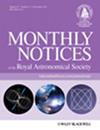PSF 误估和星系群偏差对使用 CNN 进行精确剪切测量的影响
IF 4.7
3区 物理与天体物理
Q1 ASTRONOMY & ASTROPHYSICS
引用次数: 0
摘要
遥远星系的弱引力透镜是暗能量的有力探针。本研究旨在研究卷积神经网络(CNN)在精确剪切估算中的应用。特别是,利用浅层 CNN,我们探索了点扩散函数(PSF)误估和 "星系群偏差"(包括 "分布偏差 "和 "形态偏差")的影响,重点是下一代巡天的精度要求。我们模拟了一个由噪声盘星系和椭圆星系组成的星系群,并采用了一个能代表欧几里得类巡天观测的 PSF。假设估计剪切与真实剪切之间存在线性关系,我们对 CNN 所达到的精度进行量化,并测量乘法偏差(m)和加法偏差(c)。我们利用一个非常规损失函数来减轻噪声偏差的影响,并在以下情况下测量 m 和 c:(i) 使用不正确的星系椭圆度分布或大小-星等关系,或错误的形态类型比例来描述星系群(分布偏差);(ii) 使用不正确的星系光剖面(形态偏差);或 (iii) 使用大小或椭圆度偏离真实值的 PSF(PSF 误估)。我们将结果与 Euclid 对 PSF 模型形状和大小的要求进行了比较。最后,我们概述了 CNN 在精确剪切估算方面大有可为的进一步工作。本文章由计算机程序翻译,如有差异,请以英文原文为准。
Impact of PSF misestimation and galaxy population bias on precision shear measurement using a CNN
Weak gravitational lensing of distant galaxies provides a powerful probe of dark energy. The aim of this study is to investigate the application of convolutional neural networks (CNNs) to precision shear estimation. In particular, using a shallow CNN, we explore the impact of point spread function (PSF) misestimation and ‘galaxy population bias’ (including ‘distribution bias’ and ‘morphology bias’), focusing on the accuracy requirements of next generation surveys. We simulate a population of noisy disk and elliptical galaxies and adopt a PSF that is representative of a Euclid-like survey. We quantify the accuracy achieved by the CNN assuming a linear relationship between the estimated and true shears and measure the multiplicative (m) and additive (c) biases. We make use of an unconventional loss function to mitigate the effects of noise bias and measure m and c when we use either: (i) an incorrect galaxy ellipticity distribution or size–magnitude relation, or the wrong ratio of morphological types, to describe the population of galaxies (distribution bias); (ii) an incorrect galaxy light profile (morphology bias); or (iii) a PSF with size or ellipticity offset from its true value (PSF misestimation). We compare our results to the Euclid requirements on the knowledge of the PSF model shape and size. Finally, we outline further work to build on the promising potential of CNNs in precision shear estimation.
求助全文
通过发布文献求助,成功后即可免费获取论文全文。
去求助
来源期刊

Monthly Notices of the Royal Astronomical Society
ASTRONOMY & ASTROPHYSICS-
CiteScore
9.10
自引率
37.50%
发文量
3198
审稿时长
3 months
期刊介绍:
Monthly Notices of the Royal Astronomical Society is one of the world''s leading primary research journals in astronomy and astrophysics, as well as one of the longest established. It publishes the results of original research in positional and dynamical astronomy, astrophysics, radio astronomy, cosmology, space research and the design of astronomical instruments.
 求助内容:
求助内容: 应助结果提醒方式:
应助结果提醒方式:


